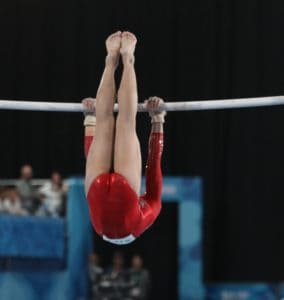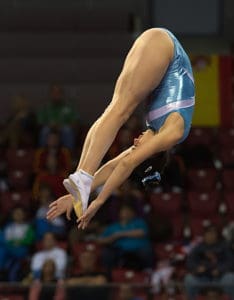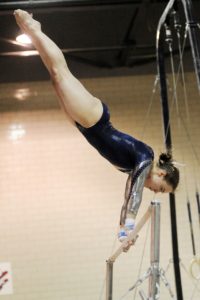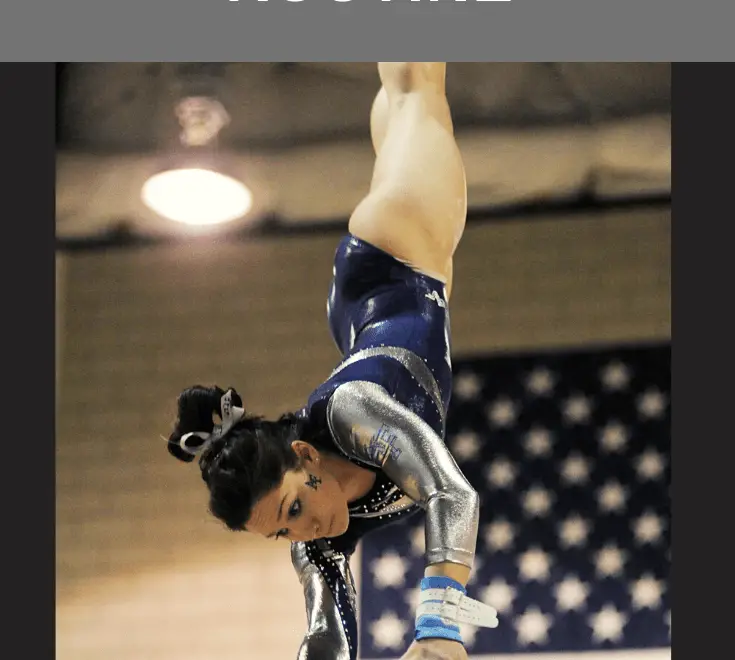This post has been updated to reflect the 2022-2026 Code of Points.
What goes into a Level 8 bar routine? It’s a little more involved than Levels 6 and 7! Level 8 is the first level that includes composition deductions, and Level 8 gymnasts are required to perform more difficult skills than the previous levels.
Overview of Level 8 Requirements
Level 8 is an intermediate optional level. In each optional level, gymnasts must perform a set number of skills with different values (Value Parts) as well as skills from specific categories (Special Requirements). If the gymnast completes all of these requirements, she will start from a 10.0. If she does not have all of the required skills, points will be deducted from her Start Value. Let’s take a look at how to determine a Start Value for a Level 8 bar routine.
Value Parts

A Level 8 bar routine must include at least 4 A skills and 4 B skills. All skills in gymnastics are evaluated based on their difficulty level, and they are given a value from A through E. A skills are the easiest, while B skills are a bit more difficult. The gymnast can choose the skills that she can perform the best in each of these difficulty categories. Each A skill is worth 0.10, and each B skill is worth 0.30.
Selected C skills are considered allowable. These skills are:
- Cast handstand ½ pirouette
- Clear hip handstand
- Clear hip handstand ½ pirouette to regular grip
- Stalder to handstand
- Stalder to handstand ½ pirouette to regular grip
- Toe-on to handstand
- Toe-on to handstand ½ pirouette to regular grip
The gymnast may perform as many allowable C skills as she wants, without penalty. When the judges count Value Parts, C skills can replace B skills, and B skills can replace A skills. A less difficult skill can never replace a more difficult skill, however.
Each gymnast is allowed one restricted C skill per routine. Additional restricted C skills (in chronological order) will incur a 0.50 deduction from the Start Value. In addition, these skills do not receive Value Part credit and cannot be used to fulfill Special Requirements.
Level 8 gymnasts can perform a straddle back to clear support (B). If the straddle back goes to handstand, it becomes the one restricted C element that the gymnast can perform. Any other restricted C’s after that would receive a 0.50 deduction and will not receive Value Part credit.
Level 8 gymnasts can also perform a bail (underswing or long swing 1/2 turn) to clear support. If the bail comes from handstand, it becomes the one restricted C element that gymnasts can perform. No other restricted C’s are allowed after it. Level 8’s cannot perform a bail to handstand, as it is a D skill.
D and E skills are not allowed at Level 8. Any D or E skill performed will receive a 0.50 deduction from the Start Value for a restricted skill.
It has also been clarified that if a gymnast does a cast handstand preceding a skill, then does the same skill with a short cast preceding it, the skill can get Value Part credit twice due to a different skill preceding it.
Special Requirements
In addition to the Value Part requirements, each gymnast must fulfill all of the Special Requirements in order to start from a 10.0. There are 4 Special Requirements for Level 8 bars, each worth 0.50. These Special Requirements are:
- One bar change
- One B 360° circling skill from Group 3, 6, or 7
- One B skill with flight or LA turn
- Salto dismount, minimum A value
Bar Change
The gymnast must change bars at least once during her routine. Most commonly, a Level 8 gymnast will start her routine on the low bar, and perform a squat or stoop on to the high bar for her bar change. Bar changes can also go from the high bar to the low bar, such as a bail or straddle back.
B Circling Skill from Group 3/6/7
A Level 8 bar routine must include a 360° circling skill from Group 3, 6, or 7. In case you don’t have your Code in front of you, these groups consist of the clear hips, stalders, and toe-on skills. Not every skill listed in these three groups will fulfill the requirement, though. The key words here are 360 degree circling skill. This means that a toe-hecht from low bar to high bar will not fulfill the requirement, because it does not circle all the way around the bar.
These circling skills are expected to reach 45° above horizontal. If they achieve handstand, at Level 8, they would still receive a B Value Part. This means that the focus should be on good execution and technique, rather than getting to handstand any way possible. It’s very common to see body position errors, bent arms, and leg separations on circling skills.
B Skill With Flight or LA Turn
First, let’s define the types of skills that fulfill this requirement. The definition of a flight skill is a skill in which the hands release and regrasp the bar. A skill with LA turn is one that has at least a ½ turn in the skill.
The most common skill I see that fits into this category is a cast handstand ½ pirouette. The ½ pirouette is a great skill because it is very progressive. It teaches basic pirouetting technique, which is important at the higher levels. A Level 9 or 10 gymnast can choose a pirouette to combine with another difficult skill to earn bonus points.
But I have a gymnast who can’t cast to handstand yet! What should I do?
Don’t worry, there are several other skills that can be used to meet this requirement. If she has a great clear hip to handstand, she could do a clear hip pirouette. Maybe she’s a great swinger? Try an overshoot (bail), or a straddle back. Some coaches might not want to have their Level 8’s do a bail because they aren’t allowed to bail to handstand until Level 9, and the technique is different for a bail to support. But if the bail to support works for you and your gymnast, give it a try! If none of these are working for you, a straddle cut is a B flight skill. Personally, I’d avoid this one unless she can’t do anything else, because it just doesn’t progress to anything at all.
There are also some restricted C skills that can be used to fulfill this requirement. Some examples are:
- Straddle back to handstand
- Toe hecht from low to high bar (does NOT count for Group 3/6/7 requirement)
- Bail from handstand to front support
- Peach salto roll from high bar to low bar
Have some fun and play around with some different options!
Salto Dismount

The routine must finish with a salto dismount. All dismounts must be initiated from the high bar unless otherwise stated. This dismount could be a back salto or front salto, with or without twist. If the gymnast has no other restricted C’s in her routine, she could do a double flyaway.
Level 8 Bars Composition Deductions
Compared with the other events, there are fewer composition deductions on Level 8 bars. Here’s what to include in your routine to avoid these deductions.
Dismount Composition (Up to 0.10)
The expected level of dismount, to receive no deduction, is a B dismount OR a B skill into an A dismount. If the gymnast performs an isolated A dismount, she will receive a 0.10 deduction. Here are some examples.
- Flyaway 1/1 twist (B)
NO deduction - Double flyaway (C, counts as B)
NO deduction
Make sure there are NO other restricted C elements in the routine, or the gymnast will lose credit for the dismount Special Requirement. - Giant – layout flyaway (B+A)
NO deduction - Clear hip, tucked flyaway (B+A)
NO deduction - Layout flyaway (A)
0.10 deduction - Front flyaway (A)
0.10 deduction - Underswing dismount (A)
0.10 deduction
0.50 Special Requirement because no salto dismount
Lack of Elements that Achieve or Pass Through Vertical (up to 0.20)
There is no set number of elements required to achieve or pass through vertical. If the gymnast never reaches vertical during the routine, the maximum deduction of 0.20 would be applied. If she only reaches vertical one time, I would likely deduct 0.10, as the deduction reads plural “elements”. Because of the way the deduction is written, I would expect her to achieve vertical at least twice during the routine. If she does two giants, but her casts are all short, this deduction could be applied, as the expected angle for Level 8 casts is to handstand.
Uncharacteristic Element (0.10 each time)
There is a 0.10 deduction each time a gymnast performs an uncharacteristic element. Examples of uncharacteristic elements are as follows:
- Squat-on low bar (facing out), ½ turn to catch high bar
- Climbing onto the low bar to reach the high bar (also will usually incur a rhythm deduction)
- Swing forward on high bar, place feet on low bar to transition (with or without ½ turn)
Considerations When Constructing a Level 8 Bar Routine

Ok, that’s a lot of information about Level 8 bars! Now, what skills are the best to include in the routine? Well, it depends.
First, start by considering the gymnast’s abilities and goals. Is this Level 8 gymnast 8 years old and on the elite track? Or is she 17 and just doing a couple of club meets to stay in shape for high school gymnastics? These two gymnasts will have very different goals for their routines.
Skill Selection
If the gymnast has aspirations of competing at the higher levels, make sure she is training skills that will prepare her for Level 9 and 10. Does she hope to get a college scholarship? Read the NCAA manual, and think about what skills would transition well to a collegiate routine. Currently, Level 9 and 10 gymnasts must perform an element with an LA turn. Knowing this, it’s a good idea to train a pirouette or a bail.
But within these parameters, play to your gymnasts’ strengths. Some kids have a really strong cast and will do well with cast handstand pirouettes. I knew one gymnast who could barely cast above horizontal, but she could do an incredible clear hip. This gymnast might want to work on a clear hip pirouette (while still training casting of course).
Always evaluate the gymnast’s ability to perform skills with good form and technique when deciding which skills to use. There are loads of execution deductions on bars, and a routine filled with bent arms and poor body position will never score well.
Angle Deductions
Another big separator of Level 8 bar routines is angle deductions. Casts should reach within 10° of handstand for no deduction. If the cast is only horizontal, the deduction is 0.30, and deductions range from 0.05-0.30 depending on the angle of the cast. The exception to this is that there are no cast angle deductions before a bail or a peach. Circling skills are also subject to amplitude deductions, and a late completion of a pirouette will result in an up to 0.30 deduction. Gymnasts who complete the pirouette late are also more likely to drag their feet on the floor on the kip afterward (up to 0.50 depending on the severity of the hit).
To sum it up, play around with different skills, and choose those that the gymnast can perform the most effortlessly. Focus on good form and technique as the gymnast learns to reach the handstand position during her skills. And have fun learning to swing big!
References
USA Gymnastics J.O. Code of Points, 2022-2026.
